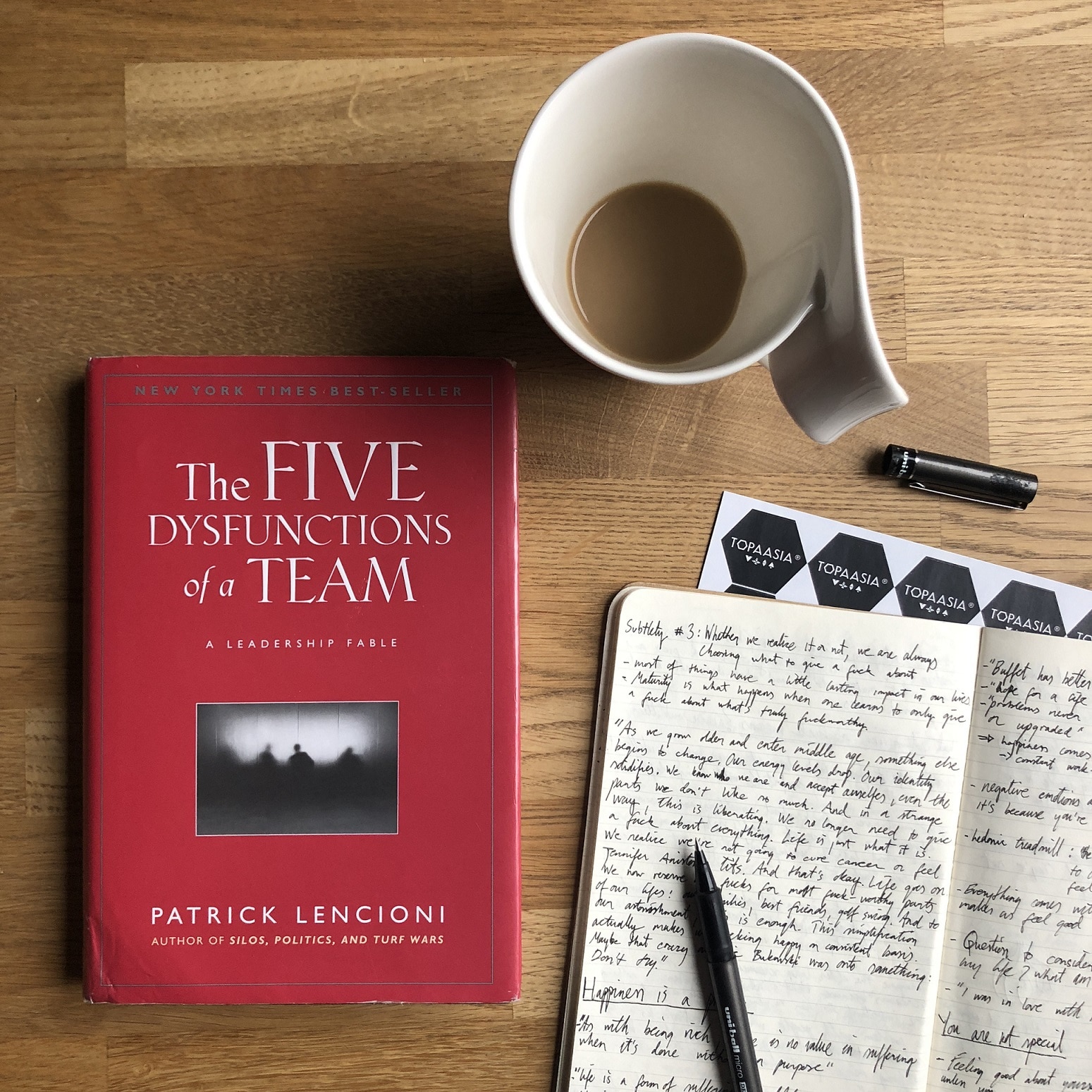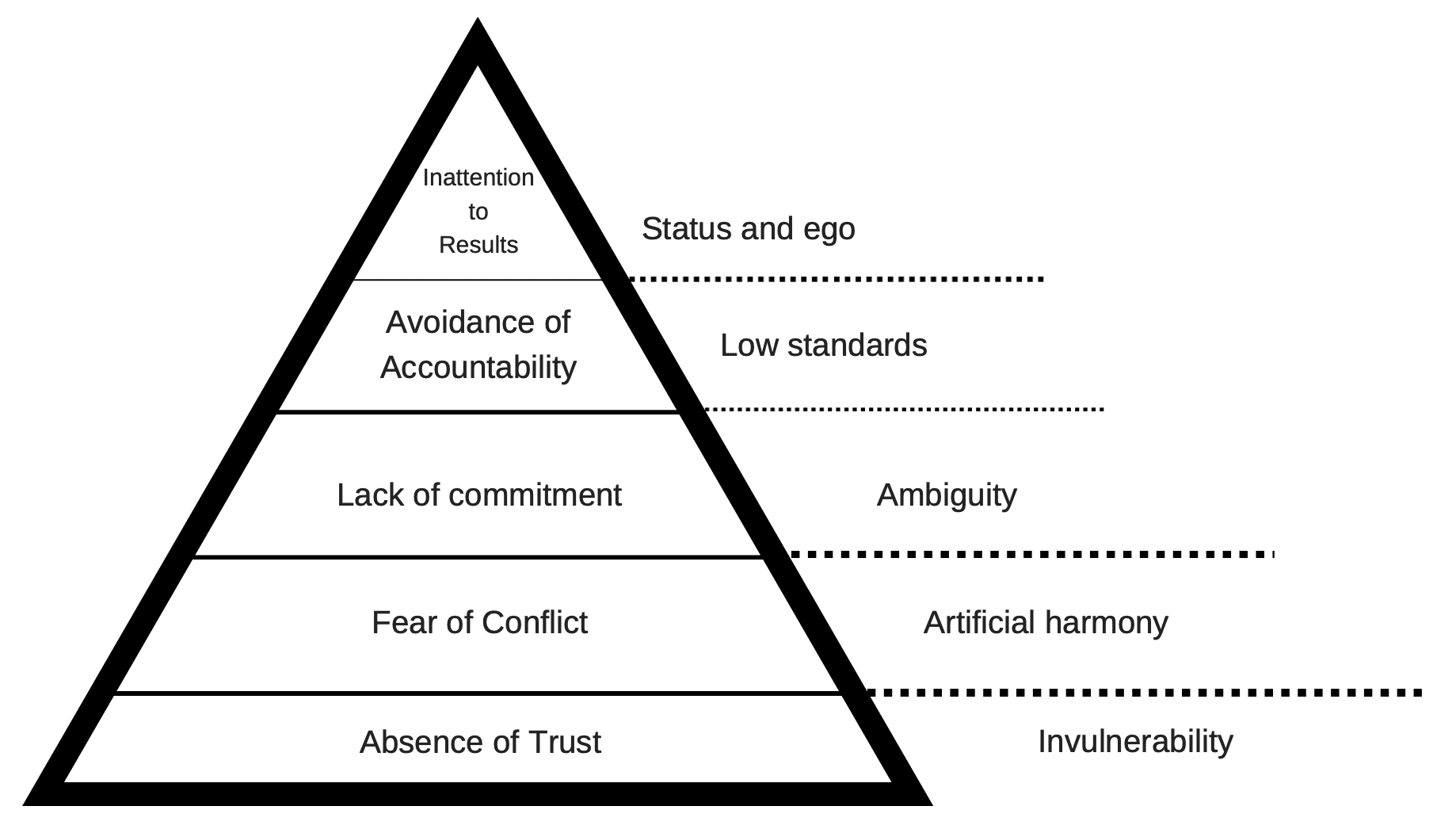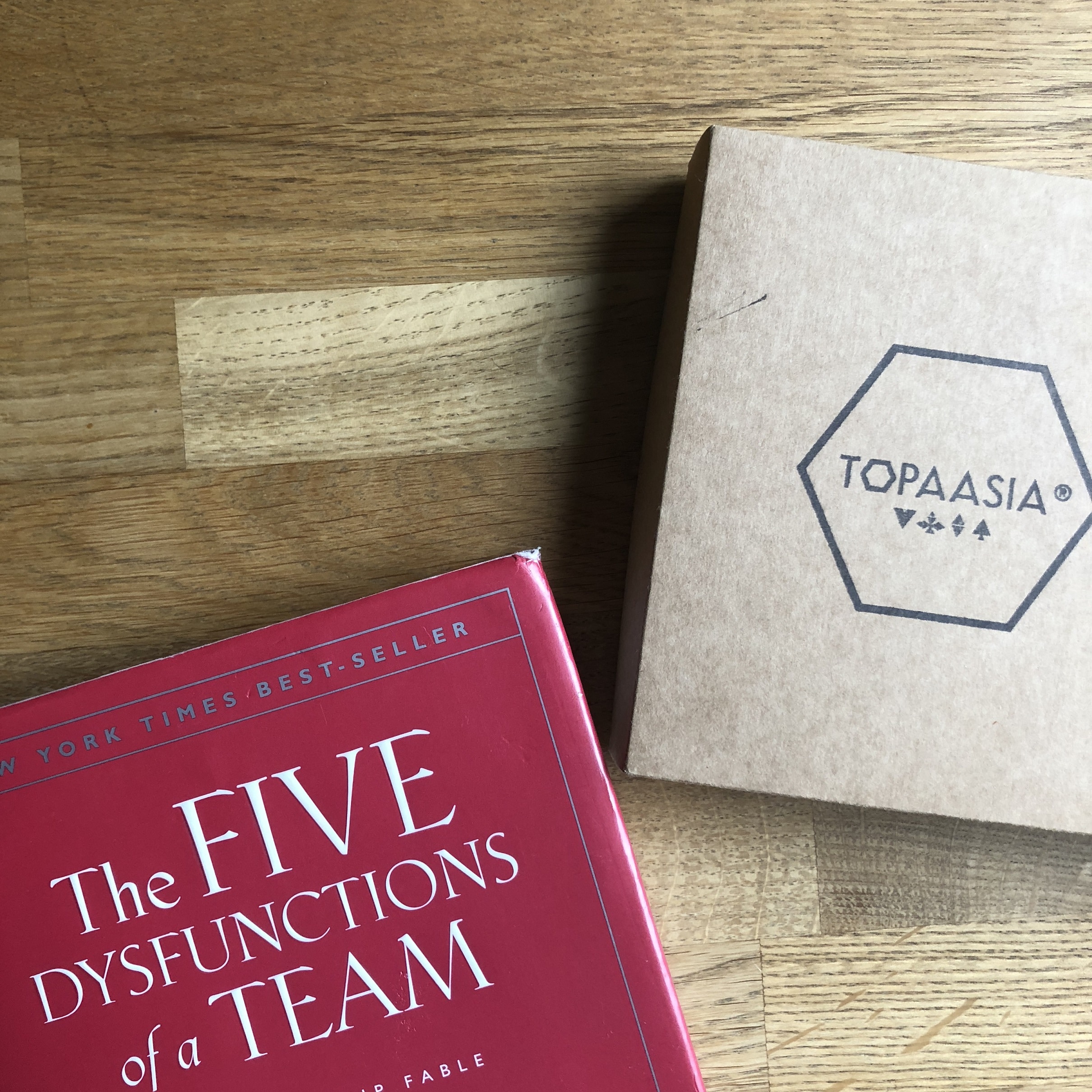The Five Dysfunctions of a Team and how to deal with them
The Five Dysfunctions of a Team (2002) is a leadership tale written by organizational consultant Patrick Lencioni about teamwork and what things usually go wrong in teamwork. The book is written in the form of a story about the management team of an imaginary technology startup. Only the last twenty pages are more traditional business literature in sense of practical problem-solving. The book is quick to read and offers solutions to those interested in the challenges of teamwork.

At Topaasia, we read this book among the founders and decided to write about it because of the universality and importance of the subject. The topic is close to our gamified dialogue service: Topaasia. In the course of game sessions, you can identify team dysfunctions according to what you dare to talk about and what team doesn’t bother to talk about.
The Five Dysfunctions of a Team

The picture shows the team’s five dysfunctions and their manifestations on the right.
1. ABSENCE OF TRUST
Lack of trust means team members don’t trust each other and don’t dare to be vulnerable close to each other. Team members are not helped, help is not dared to be asked, free brainstorming is not possible, nor is giving feedback.
In the story of the book, the team begins to build trust by sharing personal stories about themselves that remind the other team-members that each of them is a real person, and not “just working here”. There is much more underneath the “work-me”. One way we use and suggest to build trust and learn about the personal stories of other team members is to write a learning agreement. A learning agreement is a self-assessment method introduced by Cunningham (1995) that asks simple questions:
- Where have I been?
- Where am I now?
- Where am I going?
- How do I know I’m there?
A learning agreement is not an easy tool. In the new team, learning agreements are easily on the level of scrathing the surface. The better team members know and trust each other, the more deeply they dare to tell about themselves in the learning agreement.
2. FEAR OF CONFLICT
Fear of conflict is reflected in the artificial harmony that is often present in the early stages of a new team. We do not dare to say development suggestions directly to others, nor do we dare to give or ask for feedback. Everything is seemingly fine. Following Katzenbach’s and Smith’s team performance curve theory, this could be called the “pseudo-team” phase.
Fear of conflict may be present in a longer-running team if the team is not accustomed to bringing difficult topics to the table and dealing with them. This leads to avoidance of responsibility and indifference.
What to do about fear of conflict?
According to Lencioni, first, the team needs to understand that conflicts are a healthy thing and not something to avoid. Second, one of the team members may be assigned a role as a digger of conflicts. In this role, the task is to bring to light the issues of the team that are rubbing or not agreed upon. The third thing is to remind people when a conflict arises that people have permission to have a conflict.

3. LACK OF COMMITMENT
In this dysfunction, the team member is involved in the team, but is not committed to the team’s activities and goals. An example in the book is the management team, whose members felt the issues of their own department were more important than the issues of the management team. This leads to silos because the interests of your own department conflict with the management team.
According to Lencioni, the lack of commitment is due to too much consensus and reassurance. Reducing consensus does not mean that not all team members will be heard in decision-making. Instead, clarity of decisions should be sought and the need for certainty reduced.
One way to achieve clarity:
- Echoes . At the end of the team meeting, briefly review what was decided and choose how to communicate the decisions to others. This will help the team see if they agree with the decisions. Team members can have several different perspectives on the same decision.
One way to eliminate over-assurance:
- Worst case analysis . The team sets itself “worst-case-scenario” if seeking too much assurance stops action. It is often found that the worst thing that can happen is something you are able to live with. In Stoic philosophy this is called negative visualization.
4. AVOIDANCE OF LIABILITY
A team insidiously instills low standards for itself if team members are not held accountable and team members dare not challenge each other. At Topaasia Ltd, too, it is sometimes a challenge for us to challenge a team member about his or her area of responsibility and results, because “they are his or her responsibility, he or she knows better”.
One way to talk about responsibilities is to display a scoreboard of essential metrics in the team’s office. The Four Disciplines of Execution – book suggests that you should focus on just a few essential metrics and measure them. There are two types of metrics:
- Lag metrics – An issue that is ultimately to be improved, e.g. sales or customer experience. These are things that usually come with a delay of immediate action.
- Lead metrics (Lead metric) – An issue that can be used to influence matters that are delayed. Lead metrics are things that can be directly affected. E.g. the number of sales calls made or the number of appointments arranged.
It is a good idea to measure commonly agreed lead metrics on a daily basis and discuss the results and changes that appear in them from time to time. In the longer term, it’s a good idea to look at delay meters.

5. INATTENTION TO RESULTS
In this dysfunction, team members put their own personal success, reputation, and honor before the team’s results. According to LencionI, this is the team’s main sin. A good team member must be able to put the commonly agreed goals before personal goals. Some team members don’t care about team results because they are content about status and an image to belong to a particular team . Another reason for the indifference to results is that the team has not learned to be results-oriented, but views its activities more as a struggle to survive.
Ways to get your team focused on results:
- Tying joint rewards for achieving common goals. This does not mean a stick and a carrot, but a team’s common understanding of what is essential and worth pursuing.
- Public sharing of results. Once a month, the Jyväskylä Team Academy used to share among the house the turnover of the teams, the biggest projects, successes and fails in an event called “Headcount”. This was a great way to kick off your own doing, as the results of all the teams were clearly on display for comparison.
WHAT ELSE CAN I DO TO HELP TEAM OVERCOME DYSFUNCTIONS?
In summary, the proposals made in Lencioni’s book:
- Talk more between your team, especially about common practices.
- Share more information about yourself and your motives.
- Visit secluded retreats with your team several times a year to discuss important things in peace, such as development, strategy, and feedback.
Our own additional suggestions:
- Do a few different self-awareness exercises and share them with each other. Good such frameworks include e.g. Belbin ‘s Team Role Test, Big Five – Personality Test, Learning Agreement, and Four tendencies Framework.
- Play Topaasia games to get to the heart of matters quickly You can try Topaasia for free on the digital Topaasia service
We don’t believe any single tool, method, or coaching magically creates trust between people. Trust builds from our experience over time working together and that team members behave trustworthy. However, as our team grows and remote work increases, eating our own dog-food in playing Topaasia games helps to discuss dysfunctions in a short period of time. Fear of conflict, in particular, is often overlooked in a game session at the beginning of joint workdays, as the game allows people to bring out the things that are bothering them.

Thanks for reading!
You can buy physical Topaasia games directly from our online store.
You can try digital Topaasia for free by starting the 14-day trial period
Read how Judith Mills Consulting used Topaasia to help their customers with Five Dysfunctions framework
If your team is new or you are not used to discussing how to develop as a team, we recommend the General Deck to start playing. If your team is long lasting and close, we recommend Psychological Safety or Systems Intelligence – decks.
You can also communicate directly the way you want:
1) By filling out the contact form
2) Send an email to joonas@topaasia.com or call +358 44 283 4178
